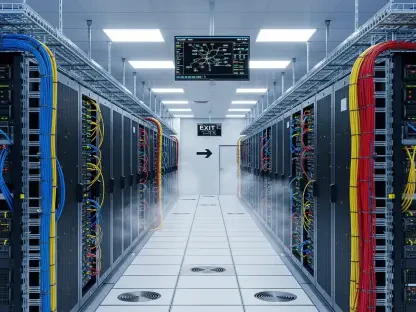The intersection of artificial intelligence (AI) and cloud computing has fundamentally redefined how organizations combat digital threats in an ever-evolving cyber landscape. As digital ecosystems grow more complex and interconnected, traditional cybersecurity measures have struggled to keep pace with increasingly sophisticated cyberattacks. As a result, the dynamic blend of AI and cloud solutions has emerged as the modern cornerstone for effective threat detection and prevention. By harnessing these technologies, businesses have embraced a proactive, intelligent approach needed to counter continuously evolving digital threats.
Revolutionizing Threat Detection and Prevention
AI and Cloud Synergy: A Powerful Defense
The integration of AI with cloud computing provides an unparalleled advantage in processing and analyzing vast amounts of data swiftly and efficiently. AI’s capabilities in pattern recognition and anomaly detection become even more potent when combined with the scalability and centralized data access offered by cloud platforms. This synergy enables organizations to expand their security operations seamlessly, a critical need to manage real-time threat detection across expansive networks. AI-driven systems, powered by cloud platforms, identify and mitigate potential cyber threats with unprecedented speed and accuracy.
Cloud platforms offer a unified security infrastructure that facilitates the deployment of AI-driven tools, like cloud-native Security Information and Event Management (SIEM) systems. These systems leverage AI to deliver automated, real-time insights into potential threats, laying the foundation for proactive threat management. Companies can now predict and respond to cyber incidents more effectively, achieving a level of security previously unattainable with conventional methods. By optimizing their security posture with AI and cloud technologies, organizations are better equipped to navigate the complexities of modern cyber threats.
Real-World Impacts and Application
Several prominent examples highlight AI and cloud computing’s transformative impact on threat detection and prevention strategies. Darktrace, for instance, utilizes machine learning to establish a baseline “pattern of life” within its networks, detecting anomalies that may indicate potential risks. This method proves particularly effective against zero-day threats, demonstrating the robust capabilities of AI without reliance on prior threat intelligence. Similarly, cloud giant Amazon Web Services (AWS) harnesses AI to monitor significant portions of global internet traffic, dynamically responding to millions of attacks per day using sophisticated techniques like honeypots and custom graph databases.
Cloud-based deep learning solutions, such as CloudShield, exemplify the power of AI in combating threats like zero-day attacks. By continually comparing incoming data against expected behavior models, these tools significantly lower false-positive rates, enhancing overall threat detection accuracy. Meanwhile, Microsoft’s AI Copilot aids organizations in managing cybersecurity through sophisticated event correlation, incident report drafting, and response recommendations. These AI-powered tools facilitate preemptive measures, allowing businesses to not only protect but also predict potential security breaches.
Sector-Specific Use Cases
Financial Sector: Battling Fraudulent Activities
In the ever-vulnerable financial sector, the threat of fraudulent activities and insider threats remains consistent. AI-based solutions offer a crucial advantage by scanning millions of transactions in real-time, flagging suspicious activities essential for safeguarding financial integrity. The ability to detect anomalies in transaction patterns ensures that banks and financial institutions can avert unauthorized access, maintaining trust and compliance. Moreover, cloud computing’s data storage and analytics capabilities enhance these AI-driven security measures, providing real-time alerts and analysis.
The healthcare sector also stands to gain immensely from AI-cloud integrations. As a prime target for cyberattacks due to the sensitive personal data it holds, healthcare facilities benefit from AI tools that monitor access to patient records and identify unauthorized entries. Cloud platforms further bolster these capabilities, underscoring the importance of robust threat detection in maintaining regulatory compliance and preventing catastrophic data breaches. Overall, AI and cloud solutions in these sectors not only bolster data protection but also enhance the predictability and speed of threat response.
Public Sector and Defense: Meeting National Security Challenges
In the public sector and defense domains, government agencies harness AI to manage voluminous datasets, effectively countering national security threats with unmatched speed and accuracy. AI-driven strategies allow for the timely identification and response to cyber incidents, safeguarding critical infrastructure and sensitive information. Cloud computing facilitates the seamless sharing and analysis of data, essential for cross-departmental collaboration in protecting national interests. The continuous refinement of AI algorithms ensures these systems remain adaptive in the face of evolving geopolitical threats.
AI and cloud technologies are integral in processing substantial amounts of information necessary for real-time threat detection and response. The fusion of these technologies results in enhanced situational awareness and decision-making capabilities, crucial for defense agencies combating sophisticated cyber adversaries. Cloud-based AI models streamline incident response protocols, providing automated alerts and notifications that enable security personnel to take decisive actions swiftly. As a result, digital defense mechanisms are fortified through AI-driven precision and cloud-enabled agility.
Addressing the Challenges
Navigating Data Privacy Concerns
Despite remarkable advancements in AI-cloud cyber defense systems, certain challenges persist. One major issue is data privacy, as AI systems require extensive datasets to function effectively, raising questions about data governance and regulatory compliance. Organizations must prioritize data protection and implement stringent measures to ensure privacy while leveraging AI for enhanced cyber defenses. Striking a balance between data accessibility and privacy safeguards remains crucial in fostering trust and compliance with evolving regulations.
Another significant challenge lies in managing false positives generated by AI systems. Although AI excels in threat detection, the frequency of unnecessary alerts can lead to analyst fatigue, potentially hindering response efforts. Organizations must employ optimization techniques and fine-tuning of AI algorithms to minimize false-positive rates, ensuring efficient security operations. Additionally, successful deployment of an AI-powered cloud security infrastructure necessitates investment in skilled personnel and ongoing training, adding complexity and operational requirements.
Evolving Threat Landscape
The nature of cyber threats continues to evolve, necessitating adaptability in security strategies. Modern threats encompass AI-generated phishing attacks, synthetic identity fraud, and advanced cyberattacks designed to mimic legitimate user activities. Reactive security models can no longer suffice, driving organizations to seek the agility and foresight provided by AI and cloud technologies. By continuously refining systems through extensive data processing, these technologies enable businesses to preemptively address emerging threats, offering proactive approaches previously deemed unattainable.
AI and cloud solutions present a swift, tailored response to the dynamic cyber threat landscape, allowing businesses to stay ahead of malicious actors. The continuous learning and refinement of AI algorithms facilitate the rapid adaptation required to counter emerging threat tactics effectively. By transitioning from reactive to proactive security models, organizations ensure enhanced resilience and preparedness, securing their digital assets against a backdrop of continuously shifting cyber adversities.
The Future of Cybersecurity
Transitioning from Adaptation to Anticipation
As the cybersecurity landscape evolves, the role of AI and cloud technologies is shifting from supplementary tools to central components in defense strategies. Enterprises, irrespective of size, are embracing these automated, intelligent solutions to address complex threat detection scenarios effectively. The emphasis is on not only protecting systems but also outsmarting attackers through predictive insights and proactive countermeasures. The integration of AI and cloud technologies signifies a paradigm shift in cybersecurity strategies, redefining how organizations manage cyber threats.
Looking forward, the evolution of cybersecurity is not just an arms race between cybercriminals and defenders but a broader technological shift emphasizing intelligence and foresight. AI and cloud solutions will continue to streamline cybersecurity operations, facilitating real-time assessments and responses that enhance digital safety effectively. Organizations must prioritize investments in technology and skill development to harness the full potential of AI and cloud-driven security solutions, securing their digital environments against future threats.
Embracing the Digital Battlefield’s Challenges
The convergence of artificial intelligence (AI) and cloud computing has revolutionized the way organizations confront digital threats in today’s fast-evolving cyber environment. As digital systems expand in complexity and interconnectivity, traditional cybersecurity tactics often fall short against the increasingly advanced nature of cyberattacks. Consequently, the synergistic integration of AI and cloud computing now forms the backbone of modern strategies for effective threat detection and mitigation. These technologies empower businesses to adopt a proactive, intelligent stance against the perpetually changing landscape of digital threats. By leveraging these powerful tools, companies are better equipped to anticipate and react swiftly to evolving attacks, ensuring their defenses remain robust and ahead of potential breaches. This transformative approach marks a significant shift from reactive to anticipatory security measures, positioning AI and cloud as indispensable assets in safeguarding digital ecosystems.









